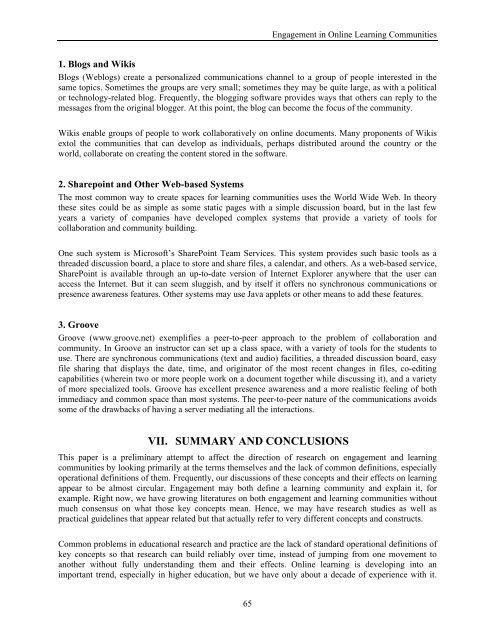Elements of Quality Online Education cation
Elements of Quality Online Education cation
Elements of Quality Online Education cation
Create successful ePaper yourself
Turn your PDF publications into a flip-book with our unique Google optimized e-Paper software.
Engagement in <strong>Online</strong> Learning Communities1. Blogs and WikisBlogs (Weblogs) create a personalized communi<strong>cation</strong>s channel to a group <strong>of</strong> people interested in thesame topics. Sometimes the groups are very small; sometimes they may be quite large, as with a politicalor technology-related blog. Frequently, the blogging s<strong>of</strong>tware provides ways that others can reply to themessages from the original blogger. At this point, the blog can become the focus <strong>of</strong> the community.Wikis enable groups <strong>of</strong> people to work collaboratively on online documents. Many proponents <strong>of</strong> Wikisextol the communities that can develop as individuals, perhaps distributed around the country or theworld, collaborate on creating the content stored in the s<strong>of</strong>tware.2. Sharepoint and Other Web-based SystemsThe most common way to create spaces for learning communities uses the World Wide Web. In theorythese sites could be as simple as some static pages with a simple discussion board, but in the last fewyears a variety <strong>of</strong> companies have developed complex systems that provide a variety <strong>of</strong> tools forcollaboration and community building.One such system is Micros<strong>of</strong>t’s SharePoint Team Services. This system provides such basic tools as athreaded discussion board, a place to store and share files, a calendar, and others. As a web-based service,SharePoint is available through an up-to-date version <strong>of</strong> Internet Explorer anywhere that the user canaccess the Internet. But it can seem sluggish, and by itself it <strong>of</strong>fers no synchronous communi<strong>cation</strong>s orpresence awareness features. Other systems may use Java applets or other means to add these features.3. GrooveGroove (www.groove.net) exemplifies a peer-to-peer approach to the problem <strong>of</strong> collaboration andcommunity. In Groove an instructor can set up a class space, with a variety <strong>of</strong> tools for the students touse. There are synchronous communi<strong>cation</strong>s (text and audio) facilities, a threaded discussion board, easyfile sharing that displays the date, time, and originator <strong>of</strong> the most recent changes in files, co-editingcapabilities (wherein two or more people work on a document together while discussing it), and a variety<strong>of</strong> more specialized tools. Groove has excellent presence awareness and a more realistic feeling <strong>of</strong> bothimmediacy and common space than most systems. The peer-to-peer nature <strong>of</strong> the communi<strong>cation</strong>s avoidssome <strong>of</strong> the drawbacks <strong>of</strong> having a server mediating all the interactions.VII. SUMMARY AND CONCLUSIONSThis paper is a preliminary attempt to affect the direction <strong>of</strong> research on engagement and learningcommunities by looking primarily at the terms themselves and the lack <strong>of</strong> common definitions, especiallyoperational definitions <strong>of</strong> them. Frequently, our discussions <strong>of</strong> these concepts and their effects on learningappear to be almost circular. Engagement may both define a learning community and explain it, forexample. Right now, we have growing literatures on both engagement and learning communities withoutmuch consensus on what those key concepts mean. Hence, we may have research studies as well aspractical guidelines that appear related but that actually refer to very different concepts and constructs.Common problems in edu<strong>cation</strong>al research and practice are the lack <strong>of</strong> standard operational definitions <strong>of</strong>key concepts so that research can build reliably over time, instead <strong>of</strong> jumping from one movement toanother without fully understanding them and their effects. <strong>Online</strong> learning is developing into animportant trend, especially in higher edu<strong>cation</strong>, but we have only about a decade <strong>of</strong> experience with it.65
















